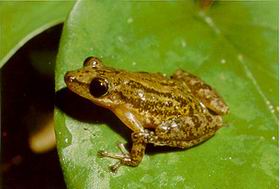
![]() Click here to hear the call of this species (120 KB MP3 file)
Click here to hear the call of this species (120 KB MP3 file)
Family: Hylidae
Common names: Stauffer's (Longnosed) Treefrog
1) Distinguishing features
Size (SVL) Adult males 21 - 25mm, females 23 - 27mm
General colouration is tan or olive-tan with dark brown markings. Dark line from the nostril to the eye and a dark interorbital spot that may be triangular in some individuals. Dark longitudinal dorsolateral stripes tend to be broken, but dark lateral stripes are often continuous, extending from behind the eye across the top of the tympanum to the inguinal region. The belly is whitish. Usually two or three dark transverse bars on the shanks and often there is some green around the eye. The iris is bronze with brown flecks. Pronounced snout that overhangs the lower jaw giving frog an elongated appearance. Skin on the dorsum is smooth, relatively long and slender forelimbs, and there is an abbreviated axillary membrane. Webbing is vestigial on hands, and toes are about two thirds webbed. Tarsal fold is absent.
2) Distribution
Up to 1,300m, but widespread at lower elevations. Known from all vegetation formations except the Subtropical Evergreen Forest and Elfin Forest formations. Appears to be absent from deep forest in those heavily vegetated formations and is a common inhabitant of the savannas, open forest and disturbed situations.
3) Natural history
Prefers subhumid and xeric habitats. Breeds following onset of rainy season and the first heavy rains. Males congregate at temporary bodies of water in pastures, on savannas, and at roadside ditches-often in association with H. microcephala and H. picta - where they call from low in the emergent vegetation or on the ground at the edge of the water. During the dry season may be found in bromeliads, rolling heliconia and banana leaves. Quite a common frog. Breeding call of males is about half a dozen high pitched cheeps followed by a trill of about the same tone. There may be two to thirty or more consecutive notes.